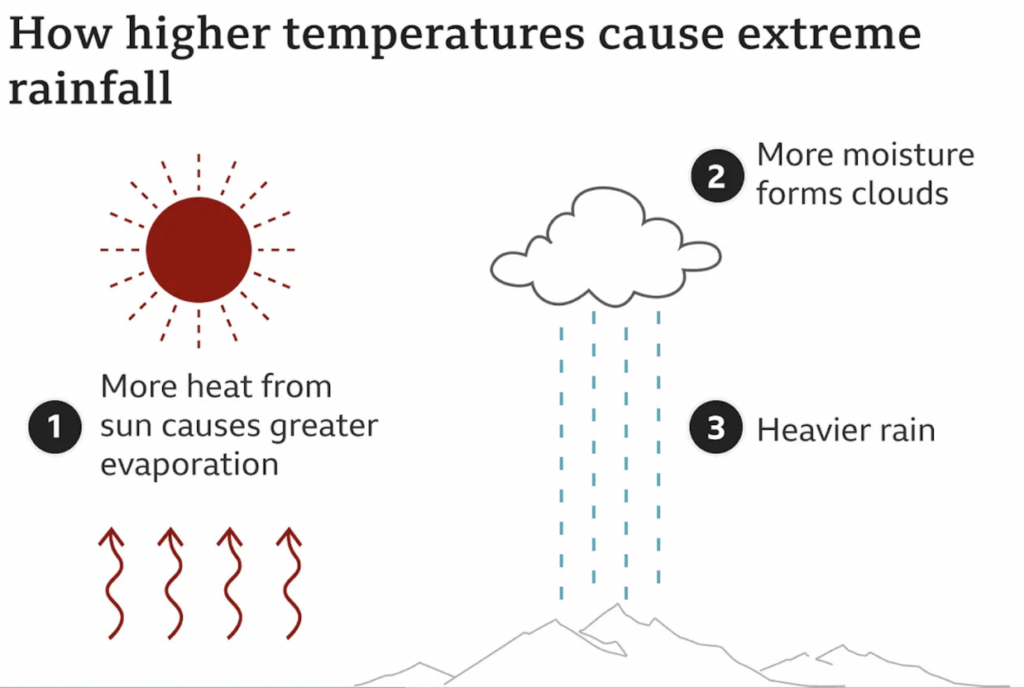Many regions are experiencing changes in stream temperatures due to climate change, which alters weather patterns and temperature regimes worldwide. As the air temperature increases, so do the temperatures of bodies of water. This temperature rise can have drastic effects on stream ecosystems. For example, cold water fish, such as trout and salmon, may struggle to survive in a warmer climate. Additionally, altered precipitation patterns, such as changes in the timing and intensity of rainfall, can lead to reduced summer stream flows. This decreases the availability of water for drinking and irrigation; Also, a certain amount of water flow is needed to maintain aquatic ecosystems.

(BBC, 2024)
Scientists are investigating adaptive strategies to mitigate these challenges associated with climate change, such as beaver reintroduction. Beavers can regulate stream environments through dam building. By creating ponds and wetlands, beavers can improve groundwater recharge, increase surface water storage, and moderate stream temperatures.
(Science Focus, 2023)
This research focused on 13 specific headwater stream reaches where 69 beavers were relocated. In this study, the researchers assessed how the presence of beavers and their dam-building activities influenced water storage in the Snohomish River basin in Washington, USA. To do this, changes in both surface water storage (such as in ponds and wetlands created by beaver dams) and groundwater storage were measured. This was useful for understanding how much more water headwater streams could hold when beavers were relocated to streams.
Another goal of this research was to examine the effects of beaver relocation on stream temperature. Through dam building, beavers create shaded areas and alter the flow dynamics of bodies of water. The researchers assessed changes in stream temperature before and after beaver relocation to determine how beavers influence stream temperatures.
Additionally, the study aimed to evaluate how specific ecosystem changes due to beaver relocation contribute to the ecosystem’s resilience overall. In headwater riparian areas, researchers assessed factors such as habitat quality, species diversity, and ecosystem stability to determine how the activities of beavers influence ecosystems on a broader scale.
The research showed that when beavers were relocated successfully, they created more water storage along the streams. For every 100 meters of stream, an extra 243 cubic meters of water was stored, mostly on the surface. The dams they built also stored groundwater, about 2.4 times more than surface water.
As a result of the dams, downstream areas experienced a cooling effect, with the water temperature dropping by an average of 2.3°C during the summer. This suggests that beaver activities, like building dams, helped to cool down the water in the streams.
The study also looked at different features of the beaver dams, such as age, condition, and how often they were maintained. These factors affected how much the water temperature changed in the streams. Overall, it was found that these dam characteristics played a role in determining the temperature changes observed in the streams.
(Vox, 2023)
These results led the researchers to suggest beaver reintroduction as a helpful strategy for offsetting some negative effects of climate change in aquatic habitats. However, the effectiveness of beaver activities on climate change mitigation can be different based on regional and environmental factors. The researchers reference “regional specificity”, which means that the success of beaver reintroduction can depend on the characteristics of the area where beavers are reintroduced, These characteristics include climate, geography, geology, and existing ecosystem dynamics. For example, the soil in an area can affect how beavers build dams and create ponds. Soil that is rich in clay or silt is ideal for building sturdy dams, whereas sandy soils are far less sturdy and can erode quite easily. So, the soil composition in a region can impact how suitable a habitat is for beaver activity. If a habitat is less suitable for beavers, then beaver reintroduction would be less successful in offsetting climate change.
In Vermont, beaver reintroduction would require planning, community engagement, and continued monitoring. The first step is identifying suitable habitats for beavers in Vermont. Researchers would need to assess certain ecosystem characteristics, such as soil composition. Additionally, researchers would need to consider the environmental impacts that beaver reintroduction would have on existing ecosystems. Beavers would be an introduced species, so they may cause unintended harm to native species or habitats. Engaging with local communities, government agencies, and conservation organizations is important for gaining support for the project. If beavers are reintroduced, it would be important to track beaver populations and assess their impact on both the ecosystem and the landscape. It may also be important to implement strategies to mitigate flooding and protect important habitats. While beaver reintroduction holds promise as a climate adaptation strategy, it is important to consider the specific characteristics of each region and how they may influence the outcomes of beaver activities.
(Vox, 2023)
References
Dittbrenner, Benjamin J., Jason W. Schilling, Christian E. Torgersen, and Joshua J. Lawler. “Relocated Beaver Can Increase Water Storage and Decrease Stream Temperature in Headwater Streams.” Ecosphere 13, no. 7 (July 2022). https://doi.org/10.1002/ecs2.4168.
Jones, Benji. “Beavers Are Heat Wave Heroes.” Vox, July 22, 2022. https://www.vox.com/down-to-earth/23273240/heat-wave-beavers-climate-change.
Stallard, Mark Poynting and Esme. “How Climate Change Worsens Heatwaves, Droughts, Wildfires and Floods.” BBC News, April 25, 2024. https://www.bbc.com/news/science-environment-58073295.
“Why Do Beavers Build Dams?” BBC Science Focus Magazine. Accessed May 1, 2024. https://www.sciencefocus.com/nature/why-do-beavers-build-dams.